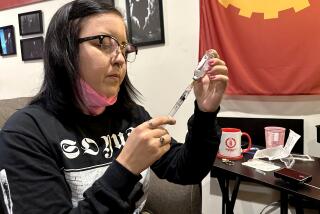United Against Diabetes : Health care: A new $1-million facility in Century City provides everything a diabetic needs to cope with the disease, all under one roof.
When actress Jean Smart does a play, she hides glucose tablets all over the set.
She keeps the tablets nearby in case her blood sugar takes a sudden dip under the stress of performance.
Best known for playing Charlene on the TV series, “Designing Women,” Smart is one of a million insulin-dependent diabetics in the United States. Smart, who has been giving herself daily insulin injections since she found out that she had the disease at the age of 13, is free of the devastating complications that diabetes can inflict--in fact, she’s never had to gulp even one of her hidden glucose tablets.
But the actress knows what it is like to live with the chronic disease, which is why she spoke last week at the opening of a new Diabetes Management & Research Center on the Westside.
An outpatient facility of Century City Hospital, the $1-million center is the only one of its kind in Southern California. Offering everything from support groups for diabetic senior citizens to a small but fully equipped gym, the center is a place where “all the needs of people with diabetes and their families can be attended to under one roof,” Medical Director Sherman M. Holvey said.
In addition to Holvey and physician Patrick Soon-Shiong, the center has a staff of eight, including a nutritionist, an exercise physiologist and a psychotherapist.
Such a facility is long overdue, Holvey said.
Diabetes, he explained, is a chronic disease in which the body does not produce or properly use insulin, a hormone needed to convert food into energy. It afflicts more than 12 million people in the United States, almost half of whom don’t even know they have it. When uncontrolled, it can cause terrible complications, including blindness, kidney disease, nerve damage, heart disease and impaired blood circulation that can lead to amputation. Impotence is a common complication in males. And every year 150,000 people die of the disease.
Holvey said the center does not wish to replace the patient’s regular physician. But it does operate with the view that the diabetic is the one who must ultimately cope with the disorder.
“The patient has to be responsible on a day-to-day basis for controlling their own disease,” Holvey said. “What this center offers is a place where diabetics can be comfortable and develop life skills they need to live a healthy life. They can’t lead a normal life, but it can be a healthy life.”
Education is one of the center’s functions. On a recent Friday morning, fourth-graders from a Carson elementary school toured the facility. They heard talks about the role that diet and exercise play in controlling diabetes and learned the warning signs, including rapid weight loss and frequent urination.
One of their classmates, 10-year-old Evette Rojas, is an insulin-dependent diabetic. Like Jean Smart, she has the less common but more severe form of the disease, in which the body does not produce any insulin on its own, perhaps because of an autoimmune reaction. (In the more common form, which typically develops in overweight people over 40, insulin is produced but not utilized in the normal way.)
Evette, who grimaces at the thought of injecting her own insulin, gets a daily injection administered by her mother. Evette says diabetes isn’t so bad “except when people eat candy in front of me, like my brother.”
In addition to hearing about diabetes, the children had a chance to experience the complex decision-making process diabetics go through as they juggle food, exercise and insulin. The children took turns sitting in front of a video display terminal playing what looked like just another computer game.
The ostensible object of the computerized exercise was to keep an airplane on the screen from crashing to earth. But the real object was to give the child a vivid sense of the maneuvering a person with diabetes must do to maintain normal blood glucose levels. The game is called BG (for blood glucose) Pilot.
According to Renee Brandon, a registered nurse who is the center’s program director, people can come to the center for a whole range of services. They may want to get instruction in the latest methods for monitoring their blood sugar and administering insulin. They may want detailed information on how to bring their weight down and the foods they should or should not eat (the center includes a test kitchen). Older diabetics may want advice on how they can exercise safely. Diabetic women who are considering pregnancy may want counseling before they try.
Smart said pregnancy and diabetes is a special interest of hers. The actress said many diabetic women are advised to not even think about becoming pregnant because of the potential risks both to themselves and their fetuses. Smart, who delivered a healthy boy almost a year ago, was advised by one doctor to terminate her pregnancy because of her diabetes. Instead, she said, she realized it was time for her to get on top of her disease. “I had no choice,” she said. “I had a baby inside me.”
Smart began testing her blood--not one or two times a day but 12--sometimes getting up at 4 in the morning to make sure her blood glucose level was as close to normal as possible. As a result, throughout her pregnancy, she said, “my blood sugars averaged the same or a little lower than my husband’s.”
Psychological counseling and support is also available at the center. Compliance--or doing what one must do to keep the disease under control--is often a problem, according to staff psychotherapist Barbara Dybnis. Compliance can be especially tough for teen-agers. “Engineers make great people with diabetes because they love those numbers to be in order,” she said. “Teen-agers don’t.”
Teen-age diabetics may wonder whether they should tell their dates about their condition. Parents of diabetics may need help in dealing with their guilt about causing a child pain during necessary injections or may seek advice on dealing with offspring who resent the attention given a diabetic sibling.
One of the most unusual features of the center is its gym, staff members said. Holvey said the health community has become increasingly aware that non-insulin-dependent diabetes can be as serious a disease in terms of its consequences as the juvenile-onset type. And yet, non-insulin-dependent diabetes can often be controlled through diet and exercise alone.
The gym at the center is supervised by exercise physiologist Claudia Graham, who is diabetic. Diabetics need to approach exercise in an informed way, Graham said. Individuals with diabetes-related retinal damage, for instance, should avoid certain kinds of weightlifting because it could cause further damage.
But Graham obviously believes diabetics can and should be active. She once trekked the Himalayas, carrying a cache of anti-nausea suppositories to make sure the altitude didn’t cause her to lose the lunch she had so carefully countered with injected insulin.
Graham said the gym can accommodate both the person who wants to exercise regularly in an atmosphere more hip to the needs of diabetics than the average health spa and the serious diabetic athlete who wants a challenge, but not at the cost of his or her health.
An example: “We can take a diabetic athlete who wants to run the Boston marathon and teach him to train to use certain fuels.”
As Holvey pointed out, some people have an elevated risk of developing diabetes. There is a higher rate among African Americans than among whites. There is an especially high incidence among Latinos and American Indians, he said.
There is no cure for diabetes. But the center is working on that too.
Some insulin-dependent diabetics have been able to stop insulin injections after receiving a pancreas transplant. Soon-Shiong, who heads the center’s Islet Transplantation Center, is one of a number of scientists throughout the world who are studying an alternative procedure: the transplantation of only those cells in the pancreas, called islets, that secrete insulin.
Soon-Shiong has been making progress toward lessening the likelihood that such cells will be rejected or destroyed after transplantation by placing them in a microcapsule before they are injected into the portal vein of the recipient.
Results in animals have been encouraging, said Soon-Shiong, who praised the center as “a unique facility that can integrate clinical care and state-of-the-art research.”
The center is located at 9910 W . Pico Blvd., Suite 200. For further information, call (213) 551-1463.
More to Read
Inside the business of entertainment
The Wide Shot brings you news, analysis and insights on everything from streaming wars to production — and what it all means for the future.
You may occasionally receive promotional content from the Los Angeles Times.










